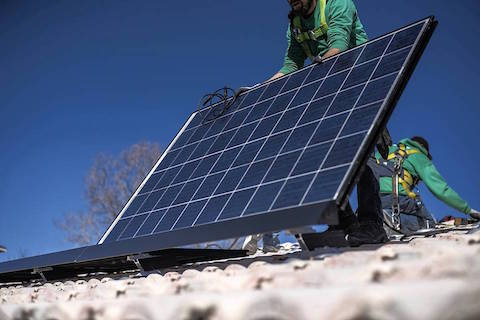forum
library
tutorial
contact

As Renewable Energy Grows, So Does
the Need to Manage Demand for Power
by Bill Spindle
Wall Street Journal, September 13, 2016
|
the film forum library tutorial contact |

|
As Renewable Energy Grows, So Does
by Bill Spindle
|
Automated systems can cut usage instantly to keep the grid in balance when supplies drop abruptly
 Demand response reducing electricity demand at certain times to keep the grid in balance is coming of age. Its increasingly playing in the big leagues of the power sector and helping reshape the electricity system.
Demand response reducing electricity demand at certain times to keep the grid in balance is coming of age. Its increasingly playing in the big leagues of the power sector and helping reshape the electricity system.
Mike Gordon was present at the birth of demand response in 2001. Back then, the company he co-founded, Joule Assets, and others like it simply rounded up a few big corporate electricity guzzlers that agreed, for a fee, to cut their usage a bit at peak hours, with notification of when that would be necessary days or weeks in advance. They made those cuts by manually flipping switches and pushing buttons at their facilities.
These days, Joule Assets and other so-called aggregators are working with tens of thousands of households, as well as businesses large and small, to shave smaller and smaller bits of electricity consumption by each user, all through automation not only at peak hours but also instantly when the energy supply from renewable sources dips unexpectedly.
You need to be able to balance the grid in real time, Mr. Gordon says. That's the critical opportunity for companies like Joule.
The more electricity users Joule enlists, the smaller the amounts each one needs to forgo and the more reliable demand response becomes as a tool for balancing supply and demand, Mr. Gordon says.
Even the little guys can play in these demand-response markets, he adds. Even homes and small and medium-size enterprises should be able to play. And together they should be more reliable than depending on a small number of big customers to cut their power use more significantly.
The need for demand response is growing as utilities grapple with a new challenge: how best to keep energy supply and demand in constant balance on the grid as the supply increasingly depends on fickle renewable-fuel sources.
Utilities long ago figured out how to get consumers and businesses to scale back their electricity use at known times of peak demand, so that the grid isn't overtaxed. But wind and solar power sources aren't so predictable. Winds can die down or the sun can be obscured, sometimes with little or no warning. That puts huge strains on a grid designed for a steady flow of electricity from traditional coal, natural-gas or nuclear generators.
For now, utilities mostly deal with grid imbalances caused by supply disruptions from renewables by contracting with natural-gas-fired or hydroelectric plants to quickly generate more electricity on short notice. But more are turning to demand response for help.
A recent pilot project in Washington state formed a nonprofit aggregator to help balance out the grid system operated by the Bonneville Power Administration in the Pacific Northwest.
The administration has some 6,000 megawatts of wind generation that can unexpectedly disappear if the wind stops blowing, more variability than the hydropower plants at its disposal can easily handle alone. As an experiment, the state last year set up Energy Northwest as a nonprofit to aggregate 35 megawatts of electricity demand it could take off the grid within 10 minutes when called upon.
There's a heightened interest in demand response in the region, says John Steigers, who heads the Energy Northwest project.
There's a heightened interest in demand response in the region, says John Steigers, who heads the Energy Northwest project.
Energy Northwest tapped a variety of electricity consumers to scale back demand. It minutely lowered the voltage briefly when necessary at 15 electrical substations in the grid for the city of Richland, in southeastern Washington, diminishing the power consumption of 70,000 residents. It also signed up two paper factories that agreed to allow some of their pulping machinery to be automatically shut down for short periods. And a facility that stores batteries for commercial use and regularly recharges them agreed to cease charging when called upon.
Energy Northwest says it responded to 85 requests for demand cutbacks in the one-year pilot project, and deems 81 of those responses successful, meaning it provided the requested amount of demand reduction within 10 minutes.
The Northwest Power and Conservation Council, an authority set up by Idaho, Montana, Oregon and Washington to plan for the region's power needs has said the area will need as much as 600 megawatts of such new demand-response resources over the next five to six years, to handle stresses on the grid from both peak demand and unpredictable interruptions in renewable-energy supply.
Already, Energy Northwest has been asked to put together a new demand-response program to help address periods of peak demand south of Alston, Ore., without the construction of new transmission lines. And several communities in other parts of the country are working with utilities to implement demand-response programs as an alternative to building new generating plants.
Mr. Gordon, the Joules CEO, believes the desire of communities to avoid the construction of expensive and intrusive new power plants and transmission lines will increasingly drive participation in demand-response programs. He figures the business could double in the next few years.
learn more on topics covered in the film
see the video
read the script
learn the songs
discussion forum
